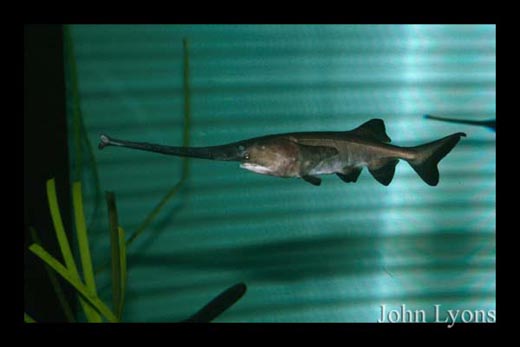Reproduction
The American Paddlefish has a unique sensitivity to the flow of water. They prefer slow flowing water for growth and development but fast flowing, deep water with gravel substrates for spawning. Male Polyodon spathula are larger in size compared to the females. Male American Paddlefish reach sexual or reproductive maturity between six to seven years, with an average of six and a half years, while the females reach sexual or reproductive maturity between ten to twelve years, with an average of eleven years. Paddlefish roe, or eggs, are a greenish black pigment, desired by many to make into edible caviar. Paddlefish have transparent roe that develop a notochord within twenty-four hours. By day four, a heartbeat can be heard and by day five, the young Paddlefish has already hatched and begun its life in larval form. The larval from of Polyodon spathula do not have the prolonged rostrum, or snout, like the adult Paddlefish. At the length of 17mm. (3/4in.), the larva only has a lump on its nose with minute barbels. By the time the larva has reached 35mm. (1.5in.) long, it has grown a recognizable snout. A paddlefish’s snout is one-third of its total length when it becomes an adult. The snout, or rostrum, is a distinctive paddle shape that is broader towards the tip than it is at the base. Tens of thousands of sensory receptors can be found on the paddlefish’s rostrum as well as electroreceptors covering the head and gill covers. To see an up close view of these sensory receptors, see Figures 8 and 9. It is interesting how Americans today compare to the early Americans in their acceptance toward Paddlefish roe. Early Americans did not consider paddlefish edible, but later commercially accepted the paddlefish. Now, Americans just can’t get enough of the Paddlefish’s roe, forcing the Paddlefish into extinction or extirpation.
What kind of organisms does the Paddlefish
interact with?
Proceed to the
Interactions page to find out.
Visit
MultipleOrganisms.net to explore more organisms!
Visit the University of Wisconsin-La Crosse,
birthplace of the Multiple Organisms web pages!
